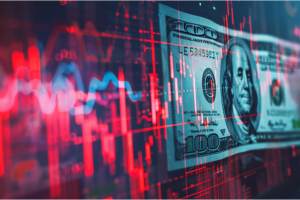
I’ve made the argument here recently that gold prices have a real chance of breaking out of their multi-year range on a potential credit event. But where does that mean for silver, which is often referred to as “poor man’s gold?” One thing you can look at is a simple price ratio of silver to gold. This ratio can provide crucial insights into the relative value of these two metals and help guide your investment strategy.
The silver-to-gold ratio is a simple concept that measures the relative value of silver to gold. You can calculate it by dividing the current price of silver by the price of gold.
In essence, this ratio tells you how many ounces of gold it would take to purchase one ounce of silver at current market prices. The silver-to-gold ratio is more than just a mathematical calculation; it’s a tool that can inform your investment strategy. It also has some interesting implications on expectations for economic activity. Gold is more of a risk-off asset, whereas silver more a signal of industrial global demand and output.
Should You Buy Silver or Gold?
If we look at two ETFs as proxies, iShares Silver Trust (NYSEARCA:SLV) for silver and SPDR Gold Shares (NYSEARCA:GLD) for gold, we can see that for the last decade, silver has underperformed gold. Silver prices have been in a tight range all year.

When the ratio is high (above the historical average), it suggests that silver is overvalued relative to gold. This could be an indication that it’s a good time to buy gold or sell silver.
Conversely, when the ratio is low (below the historical average), it may indicate that silver is undervalued relative to gold, suggesting an opportune time to buy silver or sell gold.
From a technical standpoint, it looks like the ratio is right at the midpoint, meaning it’s unclear which outperforms which here. Regardless, the two are co-moving here and could continue to do so as demand for precious metal diversification increases.
So, do you buy silver or gold? I think there’s a case for both here, although I lean more towards gold. Keep in mind that investors often see precious metals like gold and silver as hedges against inflation. If inflation expectations are high, both metals may see price increases, but the impact on the silver-to-gold ratio would depend on the relative price changes.
The Bottom Line
The bottom line here is simple.
The silver-to-gold ratio offers valuable insights for those investing in these precious metals. It can serve as a guide for allocating resources between gold and silver and help identify potential investment opportunities.
Silver has underperformed gold for a decade, and gold could outpace silver pushing the ratio lower on a flight-to-safety sequence in the yellow metal. This however still likely means silver does well, although it would underperform on a relative basis.
I think, broadly speaking, diversifying in precious metals makes sense given where we are in the cycle, and some big movements could be on the horizon.
On the date of publication, Michael Gayed did not hold (either directly or indirectly) any positions in the securities mentioned in this article. The opinions expressed in this article are those of the writer, subject to the InvestorPlace.com Publishing Guidelines.






